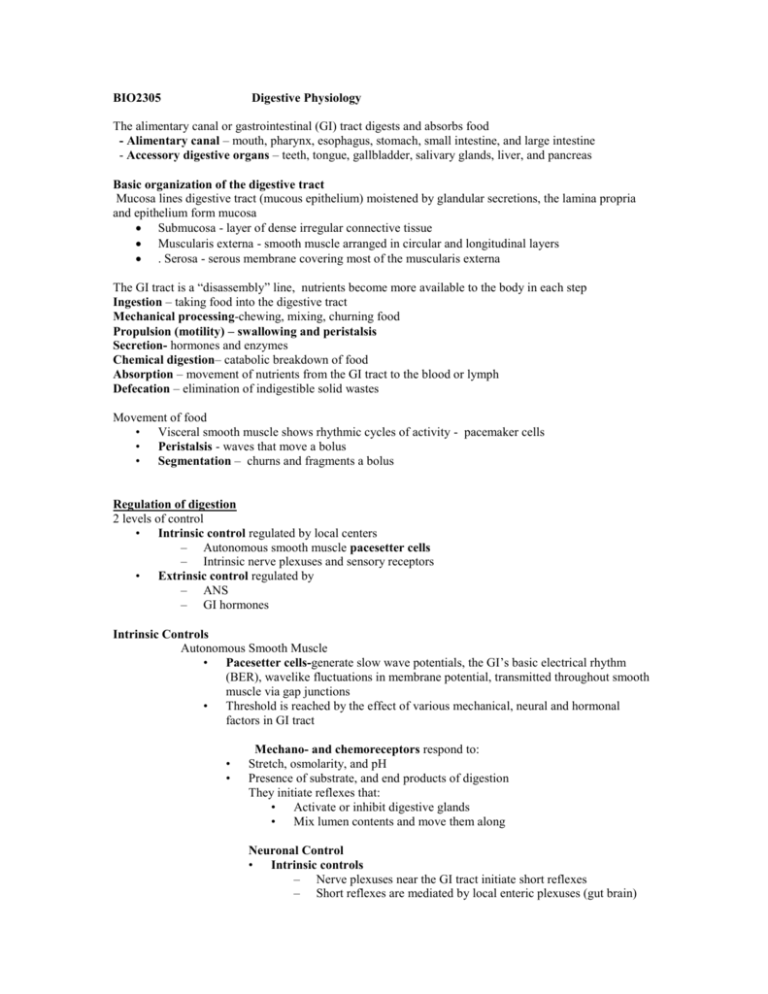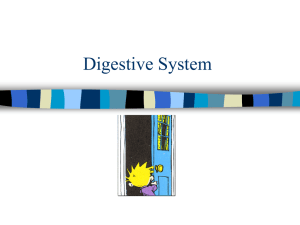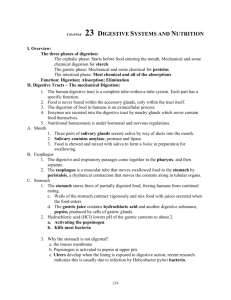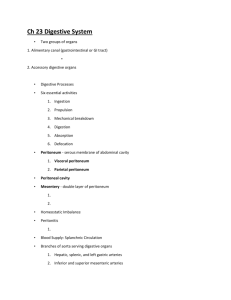The Digestive system
advertisement

BIO2305 Digestive Physiology The alimentary canal or gastrointestinal (GI) tract digests and absorbs food - Alimentary canal – mouth, pharynx, esophagus, stomach, small intestine, and large intestine - Accessory digestive organs – teeth, tongue, gallbladder, salivary glands, liver, and pancreas Basic organization of the digestive tract Mucosa lines digestive tract (mucous epithelium) moistened by glandular secretions, the lamina propria and epithelium form mucosa Submucosa - layer of dense irregular connective tissue Muscularis externa - smooth muscle arranged in circular and longitudinal layers . Serosa - serous membrane covering most of the muscularis externa The GI tract is a “disassembly” line, nutrients become more available to the body in each step Ingestion – taking food into the digestive tract Mechanical processing-chewing, mixing, churning food Propulsion (motility) – swallowing and peristalsis Secretion- hormones and enzymes Chemical digestion– catabolic breakdown of food Absorption – movement of nutrients from the GI tract to the blood or lymph Defecation – elimination of indigestible solid wastes Movement of food • Visceral smooth muscle shows rhythmic cycles of activity - pacemaker cells • Peristalsis - waves that move a bolus • Segmentation – churns and fragments a bolus Regulation of digestion 2 levels of control • Intrinsic control regulated by local centers – Autonomous smooth muscle pacesetter cells – Intrinsic nerve plexuses and sensory receptors • Extrinsic control regulated by – ANS – GI hormones Intrinsic Controls Autonomous Smooth Muscle • Pacesetter cells-generate slow wave potentials, the GI’s basic electrical rhythm (BER), wavelike fluctuations in membrane potential, transmitted throughout smooth muscle via gap junctions • Threshold is reached by the effect of various mechanical, neural and hormonal factors in GI tract • • Mechano- and chemoreceptors respond to: Stretch, osmolarity, and pH Presence of substrate, and end products of digestion They initiate reflexes that: • Activate or inhibit digestive glands • Mix lumen contents and move them along Neuronal Control • Intrinsic controls – Nerve plexuses near the GI tract initiate short reflexes – Short reflexes are mediated by local enteric plexuses (gut brain) • Extrinsic controls – Long reflexes arising within or outside the GI tract – Involve CNS centers and extrinsic autonomic nerves – Parasympathetic reflexes Intrinsic nerve plexuses – digestive tract has its own intramural nervous system – referred to as enteric nervous system. Initiates reflexes that activate or inhibit digestive glands, mix lumen contents and move them along 2 major nerve plexuses - Submucosal nerve plexus – regulates glands and smooth muscle in the mucosa - Myenteric nerve plexus – major nerve supply that controls GI tract mobility, initiates reflexes that activate or inhibit digestive glands, mix lumen contents and move them along Segmentation and peristalsis are largely automatic involving local short reflex arcs linked to the CNS extrinsic controls via long autonomic reflex arc Control of Digestion is regulated by: • Neural and hormonal mechanisms coordinate glands • Hormonal mechanisms enhance or inhibit smooth muscle contraction • Local mechanisms coordinate response to changes in pH or chemical stimuli Extrinsic control Neural and hormonal mechanisms coordinate glands Long reflexes arising within or outside the GI tract GI activity stimulated by parasympathetic innervation - ANS parasympathetic reflexes - GI hormones - hormonal mechanisms enhance or inhibit smooth muscle contraction Oral Cavity functions include: Its functions include: - Analysis of material before swallowing by touch, temperature, and taste receptors - Mechanical processing by the teeth, tongue, and palatal surfaces - Lubrication - Assistance swallowing - Limited digestion Digestive Processes in the Mouth - Food is ingested - Mechanical digestion begins (chewing) - Propulsion is initiated by swallowing - Salivary amylase begins chemical breakdown of starch - The pharynx and esophagus serve as conduits to pass food from the mouth to the stomach - Uvula guards opening to pharynx Saliva Salivary glands (3 pairs) - parotid, sublingual, and submandibular Produce saliva - watery solution includes electrolytes, buffers, glycoproteins, antibodies, enzymes Functions include: lubrication, moistening, dissolving, initiation of digestion of complex carbohydrates (starches) Saliva: Source and Composition Secreted from serous and mucous cells of salivary glands A 97-99.5% water, hypo-osmotic, slightly acidic solution containing Electrolytes – Na+, K+, Cl–, PO42–, HCO3– Digestive enzyme – salivary amylase Proteins – mucin, lysozyme, defensins, and IgA Metabolic wastes – urea and uric acid Control of Salivation Intrinsic glands keep the mouth moist, extrinsic salivary glands secrete serous, enzyme-rich saliva in response to: - Ingested food which stimulates chemoreceptors and pressoreceptors - The thought of food - Strong sympathetic stimulation inhibits salivation and results in dry mouth Deglutition (Swallowing) Involves the coordinated activity of the tongue, soft palate, pharynx, esophagus and 22 separate muscle groups. Involves phases: Buccal phase – bolus is forced into the oropharynx Pharyngeal-esophageal phase – controlled by the medulla and lower pons, all routes except into the digestive tract are sealed off, peristalsis moves food through the pharynx to the esophagus The esophagus carries solids and liquids from the pharynx to the stomach, passes through esophageal hiatus in diaphragm. Stomach 5 Functions of the stomach - Holds ingested food - Degrades this food both physically and chemically - Delivers chyme to the small intestine - Enzymatically digests proteins with pepsin - Secretes intrinsic factor required for absorption of vitamin B12 Stomach Lining The stomach is exposed to the harshest conditions in the digestive tract To keep from digesting itself, the stomach has a mucosal barrier with: A thick coat of bicarbonate-rich mucus on the stomach wall Epithelial cells that are joined by tight junctions Gastric glands that have cells impermeable to HCl Damaged epithelial cells are quickly replaced Glands of the Stomach Gastric glands have a variety of secretory cells Mucous neck cells – secrete acid mucus Parietal cells – secrete HCl and intrinsic factor Chief cells – produce pepsinogen , pepsinogen is activated to pepsin by: 1. HCl in the stomach 2. Pepsin itself via a positive feedback mechanism Enteroendocrine cells secrete gastrin, histamine, endorphins serotonin, cholecystokinin (CCK), somatostatin Regulation of Gastric Secretion Neural and hormonal mechanisms regulate the release of gastric juice, stimulatory and inhibitory events occur in 3 phases 1. Cephalic (reflex) phase: prior to food entry, prepares stomach to receive ingested material, ccelerates gastric juices Excitatory events include: - Sight or thought of food - Stimulation of taste or smell receptors Inhibitory events include: - Loss of appetite or depression - Decrease in stimulation of the parasympathetic division 2. Gastric phase: begins with the arrival of food in the stomach once food enters the stomach - Neural, hormonal – secretion of gastrin - pH drops (stimulated parietal cells) - Stomach contractions Excitatory events include: - Stomach distension - ativation of stretch receptors (neural activation) - Activation of chemoreceptors by peptides, caffeine, and rising pH - Release of gastrin to the blood Inhibitory events include: - a pH lower than 2 - emotional upset that overrides the parasympathetic division 3. Intestinal phase: as partially digested food enters the duodenum – release of hormones controls (inhibits) the rate of gastric emptying by releasing Excitatory phase - low pH; partially digested food enters the duodenum and encourages gastric gland activity Inhibitory phase – distension of duodenum, presence of fatty, acidic, or hypertonic chyme, and/or irritants in the duodenum, initiates inhibition of local reflexes and vagal nuclei, closes the pyloric sphincter, releases enterogastrones that inhibit gastric secretion Regulation of HCl secretion HCl secretion is stimulated by: ACh, Histamine Gastrin through 2nd messenger systems Release of HCL: Is low if only one ligand binds to parietal cells Is high if all three ligands bind to parietal cells Antihistamines block H2 receptors and decrease HCl release Response of the stomach to filling Stomach pressure remains constant until about 1L of food is ingested Reflex-mediated events include: Receptive relaxation – as food travels in the esophagus, stomach muscles relax Adaptive relaxation – the stomach dilates in response to gastric filling Gastric Contractile Activity: Peristaltic waves move toward the pylorus at the rate of 3 per minute . This basic electrical rhythm BER) is initiated by pacemaker cells (cells of Cajal). Most vigorous peristalsis and mixing occurs near the pylorus Chyme is either delivered in small amounts to the duodenum or forced backward into the stomach for further mixing Regulation of Gastric Emptying 2 mechanisms inhibit gastric secretion and duodenal filling: Neural enterogastric reflex Hormonal (enterogastrone) mechanisms Carbohydrate-rich chyme quickly moves through the duodenum Fat-laden chyme is digested more slowly causing food to remain in the stomach longer Digestion in Stomach Preliminary digestion of proteins via pepsin Permits digestion of carbohydrates Very little absorption of nutrients Small intestine Important digestive and absorptive functions 3 subdivisions: Duodenum Jejunum Ileum Ileocecal sphincter - transition between small and large intestine Structural modifications of the small intestine wall increase surface area Plicae circulares: deep circular folds of the mucosa and submucosa Villi – fingerlike extensions of the mucosa Microvilli –– tiny projections of absorptive mucosal cells’ plasma membranes The epithelium of the mucosa is made up of: – Absorptive cells and goblet cells – Enteroendocrine cells – Interspersed T cells called intraepithelial lymphocytes (IELs) Cells of intestinal crypts secrete intestinal juice – Secreted in response to distension or irritation of the mucosa – Slightly alkaline and isotonic with blood plasma – Largely water, enzyme-poor, but contains mucus Introduction of secretions and buffers provided by: pancreas liver gall bladder Hormones Secretin Inhibits gastric emptying in order to prevent further acid from entering duodenum until acid already present is neutralized Inhibits gastric secretion to reduce amount of acid being produced Stimulates pancreatic duct cells to produce large volume of aqueous NaHCO3 secretion Stimulates liver to secrete NaCO3 rich bile which assists in neutralization process Along with CCK, is trophic to exocrine pancreas Cholecystokinin inhibits gastric motility and secretion Stimulates pancreatic acinar cells to increase secretion of pancreatic enzymes Causes contraction of gallbladder Along with secretin, is trophic to exocrine pancreas Implicated in long-term adaptive changes in proportion of pancreatic enzymes in response to prolonged diet changes Important regulator of food intake GIP – stimulates release of insulin, inhibits gastric secretion and motility Functions of Glands of the duodenum: moisten chyme, help buffer acids, maintain digestive material in solution The Liver - largest gland in the body, performs metabolic and hematological regulation and produces bile Hexagonal-shaped liver lobules are the structural and functional units of the liver; Composed of hepatocytes, hepatocytes’ functions include: Production of bile Processing bloodborne nutrients Storage of fat-soluble vitamins Detoxification --Secreted bile flows between hepatocytes toward the bile ducts in the portal triads Composition of Bile A yellow-green, alkaline solution containing bile salts, bile pigments, cholesterol, neutral fats, phospholipids, and electrolytes. Bile salts are cholesterol derivatives that: emulsify fat, facilitate fat and cholesterol absorption, help solubilize cholesterol The chief bile pigment is bilirubin, a waste product of heme The Gallbladder -thin-walled, green muscular sac on the ventral surface of the liver, stores and concentrates bile by absorbing its water and ions, releases bile via the cystic duct, which flows into the bile duct Regulation of Bile Release Acidic, fatty chyme causes the duodenum to release: Cholecystokinin (CCK) and secretin into the bloodstream Bile salts and secretin transported in blood stimulate the liver to produce bile Vagal stimulation causes weak contractions of the gallbladder Cholecystokinin causes the gallbladder to contract, the hepatopancreatic sphincter to relax as a result, bile enters the duodenum The Pancreas 2 separate functions: Endocrine functions – secretes insulin and glucagons Exocrine functions - secretes pancreatic juice into small intestine which breaks down all categories of foodstuff, Acini (clusters of secretory cells) contain zymogen granules with digestive enzymes Composition of Pancreatic Juice Water solution of enzymes and electrolytes (primarily HCO3–) Neutralizes acid chime to provide optimal environment for pancreatic enzymes Enzymes are released in inactive form and activated in the duodenum Examples include trypsinogen is activated to trypsin Procarboxypeptidase is activated to carboxypeptidase Active enzymes secreted: amylase, lipases, and nucleases These enzymes require ions or bile for optimal activity Regulation of Pancreatic Juice Secretin and CCK are released when fatty or acidic chyme enters the duodenum CCK and secretin enter the bloodstream Upon reaching the pancreas, CCK induces the secretion of enzyme-rich pancreatic juice Secretin causes secretion of bicarbonate-rich pancreatic juice. Vagal stimulation also causes release of pancreatic juice Digestion in the small intestine as chyme enters the duodenum, carbohydrates and proteins are only partially digested, no fat digestion has taken place. Digestion continues in the small intestine: Chyme is released slowly into the duodenum. Because it is hypertonic and has low pH, mixing is required for proper digestion. Required substances needed are supplied by the liver Virtually all nutrient absorption takes place in the small intestine The most common motion of the small intestine is segmentation. It is initiated by intrinsic pacemaker cells (Cajal cells). Moves contents steadily toward the ileocecal valve After nutrients have been absorbed, peristalsis begins with each wave starting distal to the previous. Meal remnants, bacteria, mucosal cells, and debris are moved into the large intestine Control of Motility Local enteric neurons of the GI tract coordinate intestinal motility Cholinergic neurons cause contraction and shortening of the circular muscle layer, shortening of longitudinal muscle, distension of the intestine, Other impulses relax the circular muscle The gastroileal reflex and gastrin relax the ileocecal sphincter and allow chyme to pass into the large intestine Large Intestine Functions Reabsorb water and compact material into feces, absorb vitamins produced by bacteria Store fecal matter prior to defecation Other than digestion of enteric bacteria, no further digestion takes place Vitamins, water, and electrolytes are reclaimed Motility of the Large Intestine Haustral contractions - slow segmenting movements that move the contents of the colon Haustra sequentially contract as they are stimulated by distension, initiates peristalsis that forces contents toward the rectum Rectum Last portion of the digestive tract, terminates at the anal canal Defecation reflex triggered by distention of rectal walls caused by feces: Stimulates contraction of the rectal walls, relaxes the internal anal sphincter Voluntary signals stimulate relaxation of the external anal sphincter and defecation occurs Digestion and Absorption of Nutrients Processing and absorption of nutrients -disassembled organic food into smaller fragments Hydrolyzes carbohydrates, proteins, lipids and nucleic acids for absorption Chemical Digestion: Carbohydrates Begins in the mouth, salivary and pancreatic enzymes, brush border enzymes breakdown complex carbohydrates into monosaccharides Absorption of monosaccharides occurs across the intestinal epithelia via cotransport with Na+, and facilitated diffusion. Enter the capillary bed in the villi Transported to the liver via the hepatic portal vein Chemical Digestion: Proteins Low pH destroys tertiary and quaternary structure. Enzymes used include pepsin, trypsin, chymotrypsin, and elastase. Liberated amino acids are absorbed Absorption: similar to carbohydrates Enzymes used: pepsin in the stomach Enzymes acting in the small intestine: pancreatic enzymes – trypsin, chymotrypsin, and carboxypeptidase Brush border enzymes – aminopeptidases, carboxypeptidases, and dipeptidases Lipid digestion and absorption Lipid digestion utilizes lingual and pancreatic lipases Bile salts improve chemical digestion by emulsifying lipid drops. Lipid-bile salt complexes called micelles are formed. Micelles diffuse into intestinal epithelia which release lipids into the blood as chylomicrons Absorption: diffusion into intestinal cells where they combine with proteins and extrude chylomicrons. Enter lacteals and are transported to systemic circulation via lymph Glycerol and short chain fatty acids are absorbed into the capillary blood in villi Transported via the hepatic portal vein Fatty Acid Absorption Fatty acids and monoglycerides enter intestinal cells via diffusion, they are combined with proteins within the cells. Resulting chylomicrons are extruded and enter lacteals and are transported to the circulation via lymph Chemical Digestion: Nucleic Acids Absorption: active transport via membrane carriers Absorbed in villi and transported to liver via hepatic portal vein Enzymes used: pancreatic ribonucleases and deoxyribonuclease in the small intestines Water - nearly all (95%) that is ingested is reabsorbed Net osmosis occurs whenever a concentration gradient is established by active transport of solutes into the mucosal cells. Water uptake is coupled with solute uptake, and as water moves into mucosal cells, substances follow along their concentration gradients Electrolyte Absorption Most ions are actively absorbed along the length of small intestine Na+ is coupled with absorption of glucose and amino acids Ionic iron is transported into mucosal cells where it binds to ferritin Anions passively follow the electrical potential established by Na+ K+ diffuses across the intestinal mucosa in response to osmotic gradients Ca2+ absorption is related to blood levels of ionic calcium, regulated by vitamin D and parathyroid hormone (PTH)









